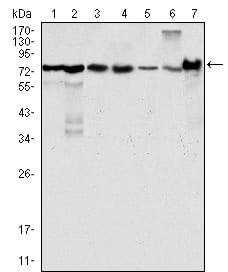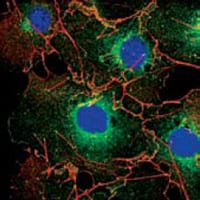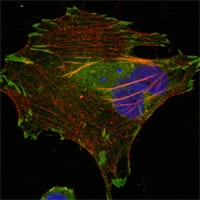




| WB | 1/500 - 1/2000 | Human,Mouse,Monkey,Hamster |
| IF | 咨询技术 | Human,Mouse,Monkey,Hamster |
| IHC | 1/200 - 1/1000 | Human,Mouse,Monkey,Hamster |
| ICC | 1/200 - 1/1000 | Human,Mouse,Monkey,Hamster |
| FCM | 咨询技术 | Human,Mouse,Monkey,Hamster |
| Elisa | 1/10000 | Human,Mouse,Monkey,Hamster |
| Aliases | LPP |
| Entrez GeneID | 4026 |
| clone | 8B3A11 |
| WB Predicted band size | 66kDa |
| Host/Isotype | Mouse IgG1 |
| Antibody Type | Primary antibody |
| Storage | Store at 4°C short term. Aliquot and store at -20°C long term. Avoid freeze/thaw cycles. |
| Species Reactivity | Human,Mouse,Monkey,Hamster |
| Immunogen | Purified recombinant fragment of human LPP expressed in E. Coli. |
| Formulation | Purified antibody in PBS with 0.05% sodium azide. |
+ +
以下是关于LPP抗体的3篇参考文献,涵盖其在不同研究领域中的应用:
1. **"The LIM protein LPP is a coactivator for the ETS domain transcription factor PEA3"**
**作者**: Gorenne, I., Jin, L., et al.
**摘要**: 该研究通过免疫共沉淀和Western blot技术,使用LPP特异性抗体,揭示了LPP作为转录共激活因子与PEA3的相互作用,促进肿瘤细胞的侵袭和转移。实验表明,LPP在转录调控中起关键作用,尤其在细胞迁移相关基因表达中。
2. **"Expression and clinical significance of LPP protein in non-small cell lung cancer"**
**作者**: Sasaki, H., Daigo, Y., et al.
**摘要**: 通过免疫组化(IHC)分析LPP抗体在非小细胞肺癌组织中的表达,发现LPP高表达与肿瘤淋巴结转移和患者生存率降低显著相关。研究支持LPP作为癌症转移的潜在生物标志物。
3. **"LPP, a novel actin cytoskeleton-related protein, fused to HMGA2 in a pulmonary chondroid hamartoma"**
**作者**: Petit, M.M., Mols, R., et al.
**摘要**: 该研究首次鉴定了LPP蛋白在细胞粘着斑中的定位,利用抗体进行免疫荧光和Western blot实验,发现LPP参与细胞骨架重组,并通过与HMGA2的融合促进肿瘤发生,提示其在细胞迁移中的关键作用。
这些文献均通过LPP抗体在分子机制、临床相关性或结构功能研究中展开分析,涵盖了癌症、转录调控及细胞骨架动力学等多个方向。
Leucine-rich polypyrimidine tract-binding protein (LPP) antibodies are immunological tools used to study the LPP protein, a member of the LIM domain-containing protein family. LPP is encoded by the LPP gene located on human chromosome 3q27-28 and is widely expressed in tissues, particularly in smooth muscle cells and fibroblasts. It functions as a transcriptional coactivator, playing roles in cell adhesion, migration, and mechanotransduction by interacting with cytoskeletal components and signaling pathways like TGF-β and Hippo. LPP contains three LIM domains that mediate protein-protein interactions, enabling its involvement in nuclear-cytoplasmic shuttling and gene regulation.
LPP antibodies are primarily employed in research to investigate LPP's dual localization (cytoplasmic and nuclear) and its association with pathological processes, including cancer metastasis, cardiovascular diseases, and fibrosis. Aberrant LPP expression has been linked to tumor progression in cancers such as breast, lung, and sarcoma, making it a potential biomarker or therapeutic target. These antibodies are utilized in techniques like Western blotting, immunofluorescence, and immunohistochemistry to assess protein expression, localization, and interactions. Commercial LPP antibodies are typically raised against specific epitopes, often validated for cross-reactivity in human, mouse, and rat models. Recent studies also explore LPP's role in cellular responses to mechanical stress, highlighting its importance in tissue remodeling and disease mechanisms.
×